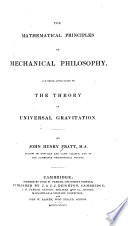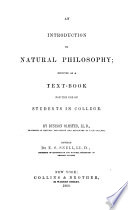 | John Henry Pratt - 1836 - 672 pages
...COR. <_'. If P act parallel to the plane, e = 0, P = W sin «. COR. .'}. If P act vertically, e = ^ - a, P = W. 114. The fifth mechanical power is the Wedge....time, sufficient to overcome the greatest forces. Puop. An isosceles wedge being introduced between two obstacles, required to find its tendency to separate... | |
 | John Henry Pratt - 1841 - 644 pages
...a. COR. 2. If P act parallel to the plane, e = 0, P = Wsin u . COB. 3. If P act vertically, e = ^v - a, P = W. 114. The fifth Mechanical Power is the Wedge....wedge being introduced between two obstacles, required to find its tendency to separate the obstacles token the wedge is prevented from being thrust back... | |
 | John Henry Pratt - 1845 - 694 pages
...horizontally, e = - a, and P = W tan a. Con, 2. If P act parallel to the plane, e = 0, P =• Wsin a. COR. 3. If P act vertically, e - ^ir - a, P - W. 114. The...prevented from being thrust back by a given force. 115. Let 2P he the force acting at the hack of the wedge (%. 44). In the figure we suppose the obstacles... | |
 | Isaac Todhunter - 1853 - 362 pages
...P act parallel to the plane, e = 0, P = IF" sin a. If P act vertically, e = -£TT — a, P=-W. 167. The fifth Mechanical Power is the Wedge. This is a...time, sufficient to overcome the greatest forces. 168. PEOP. An isosceles wedge is kept in equilibrium by pressures on its three faces; to find the relation... | |
 | Denison Olmsted - 1860 - 492 pages
...to exert upon them lateral pressures to separate them. This ia effected by a blow, or some similar means, which produces a violent pressure for a short time, sufficient to overcome a very great resistance. 134. Law of equilibrium. — Whatever be the direction of the blow or force,... | |
 | Isaac Todhunter - 1866 - 386 pages
...Mechanical Power is the Wedge. This is a triangular prism, and is used to separate obstacles byintroducing its edge between them and then thrusting the wedge...time, sufficient to overcome the greatest forces. 168. An isosceles wedge is kept in equilibrium by pressures on its three faces; to find the relation... | |
 | Isaac Todhunter - 1874 - 400 pages
...to the plane, e = 0, and P = Wsin a.. If P act vertically, e = JTT — a, and P= W. 167. The sixth Mechanical Power is the Wedge. This is a triangular...time, sufficient to overcome the greatest forces. 168. An isosceles wedge is kept in equilibrium by pressures on its three faces ; to find the relation... | |
 | Edward Albert Bowser - 1884 - 550 pages
...a triangular prism, usually isosceles, and is used for separating bodies or parts of the same body by introducing its edge between them and then thrusting...which produces a violent pressure, for a short time, in a direction perpendicular to the back of the wedge, and the resistance to be overcome consists of... | |
 | Edward Albert Bowser - 1888 - 540 pages
...a triangular prism, usually isosceles, and is used for separating bodies or parts of the same body by introducing its edge between them and then thrusting...such means, which produces a violent pressure, for n short time, in a direction perpendicular to the back of the wedge, and the resistance to be overcome... | |
| |